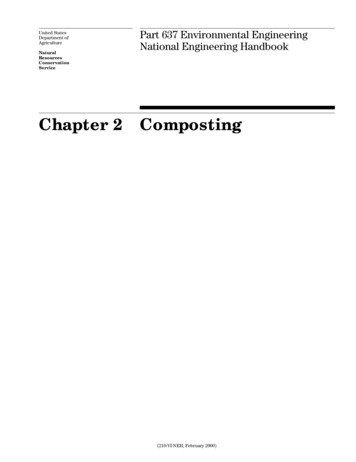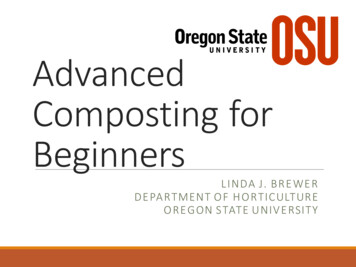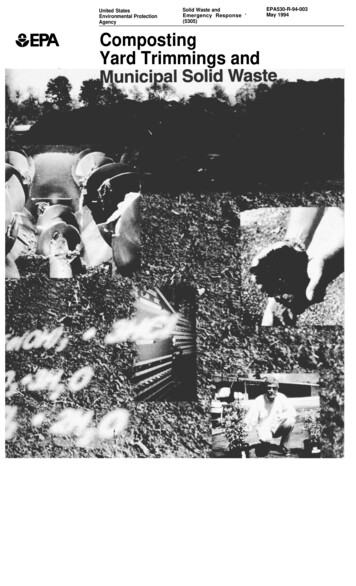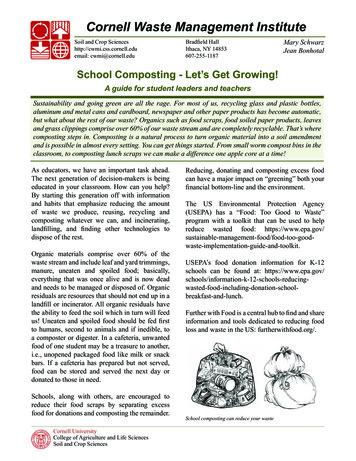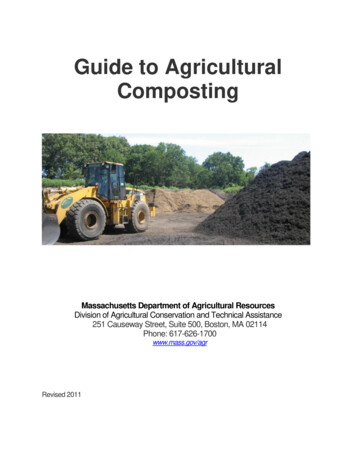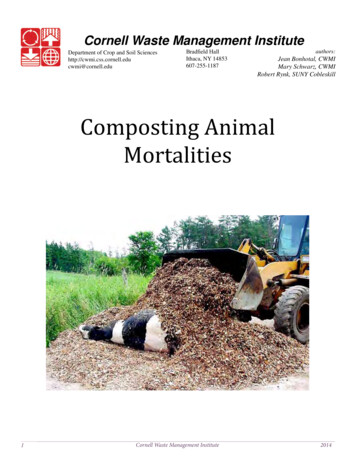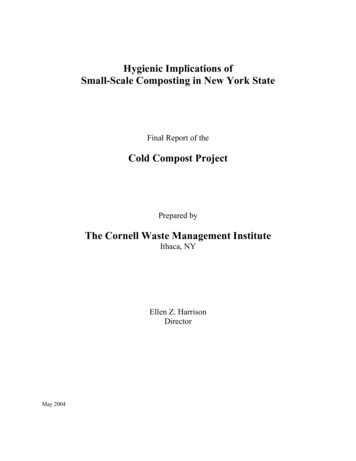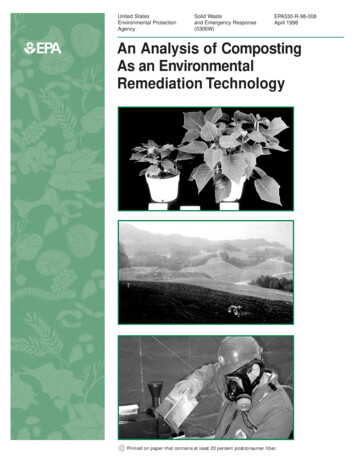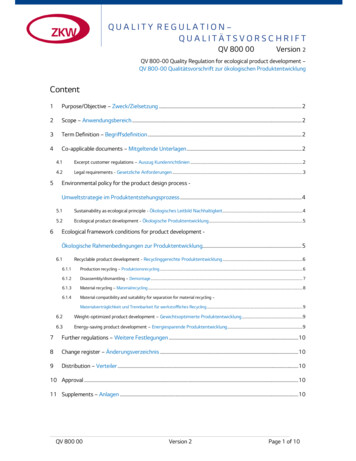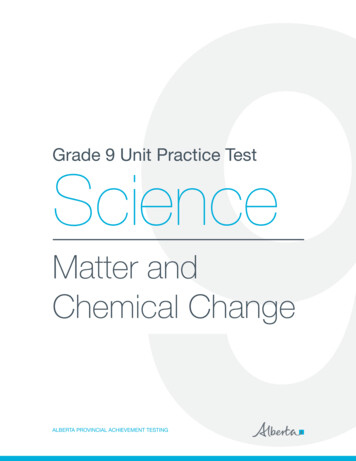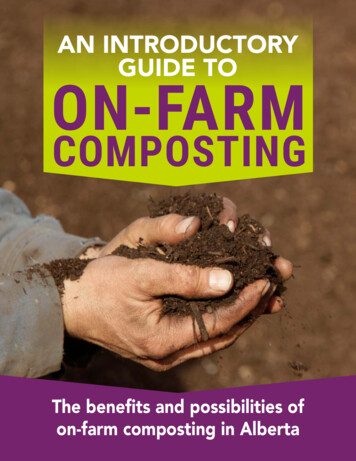
Transcription
AN INTRODUCTORYGUIDE TOON-FARMCOMPOSTINGThe benefits and possibilities ofon-farm composting in Alberta
AN INTRODUCTORYGUIDE TOON-FARMCOMPOSTINGSTATEMENT OF PURPOSEA lack of composting capacity in Alberta has led to challenges for both municipal, and Industrial, Commercial andInstitutional (ICI) organics diversion programs. But it also offers opportunities — opportunities for landowners whoare interested in composting; managers who are looking to improve sustainability; and municipalities interested incollaborating with farmers to recycle community organics in a sustainable manner.This guide was developed in support of a circular economy in the province, and it is hoped that it will:1. demonstrate the value in composting operations to municipalities, and residents.2. encourage landowners to consider on-farm composting.3. provide interested landowners with the resources they need to get started.BACKGROUND INFOIn 2019, with funding from the governments of Canada and Alberta through the Canadian Agricultural Partnership,the Recycling Council of Alberta (RCA) initiated a study of the benefits of directing organic waste generated inurban communities to land application on farmland. The first part of the project involved collaborating with staffand students at Olds College to study a successful compost operation, while also identifying opportunities andbarriers to broader adoption of composting organic waste from urban communities to the farm.In 2020, the RCA used the information from Olds College to develop a Case Study on the Stickland Farm operationnear Penhold, AB.In early 2021, this guide was developed as an introduction to farmers, ranchers and landowners who may beinterested in learning more about the opportunities of composting organic waste.This project has been made possible in part by the Government ofCanada and the Government of Alberta through the Canadian AgriculturalPARTNERSHIP*Thank you, to our many CONTRIBUTORS, including (but notlimited to): Brian Stickland and the Stickland family,Scott Gamble, John Paul, Olds College, and the On-FarmComposting Project Team.*Opinions expressed in this guide are those of the author and not necessarily those of the Government of Canada,Government of Alberta or our contributors. The Government of Canada, Government of Alberta and its directors, agents,employees, or contractors will not be liable for any claims, damages, or losses of any kind whatsoever arising out of theuse of, or reliance upon, this information.2
AN INTRODUCTORYGUIDE TOON-FARMCOMPOSTINGTABLE OF CONTENTSINTRODUCTION.4PROFILE OF STICKLAND FARMS. 21Stickland Farms - Minimizing Smell. 21What is Composting?.4UNDERSTANDING COMPOST. 21Benefits to Composting Community OrganicWaste on the Farm.4Nutrients in Compost. 22Nitrogen. 23Phosphorus. 23Potassium. 23Other Nutrients. 23Other Nutrients. 23Electrical Conductivity and Sodium. 23Moisture Content. 24Valuing Compost. 24Farm Benefits.5Community Benefits.6Environmental Benefits.6A Model for Recycling Organic Matter andNutrients from our Communities.7PROFILE OF STICKLAND FARMS.7Stickland Farms - Operational Overview.7SETTING UP AN ON-FARM COMPOSTINGOPERATION.9APPLYING COMPOST. 24Compost Application Limits. 24Compost Application Setbacks. 24Registration Application and ApprovalNotification Process.9Feasibility. 11Networking and Mentorship. 11Securing Feedstock Supply. 12Choosing a Site Location. 12Choosing a Composting Method. 13Aerated Static Pile (ASPs). 14SUMMARY. 25Site Development Checklist. 25FURTHER INFORMATION. 26Contact Information. 26Aerated Windrows vs Aerated Piles. 14Positively Aerated vs Negatively Aerated Piles. 15Aerated Piles With No or Minimal Mixing vsAerated Piles With Mixing. 15Aeration Pipes Embedded in the ConcreteFloor vs Pipes on Top of the Floor. 16Establishing a Compost Site Layout. 161. Receiving Area. 172. Bulking Agent Storage Area. 183. Active Composting Area. 184. Curing Area. 185. Screening Area. 196. Storage Area. 197. Process Water Storage. 19Mitigating Against Odour. 203
AN INTRODUCTORYGUIDE TOON-FARMCOMPOSTINGINTRODUCTIONThe purpose of this guide is to provide a foundation for landowners interested in composting organic material fromsurrounding communities for use on their farms. It provides operational information from one farm that is alreadysuccessfully processing community organic waste, as well as other suggestions and considerations for anyoneinterested in starting a similar operation. We have highlighted some of the key regulatory requirements containedin Alberta Environment’s draft Code of Practice for Compost Facilities, as well as the Nutrient ManagementGuidelines.WHAT IS COMPOSTING?Composting is the process by which materials biodegrade through the action of naturally occurring microorganisms.The resulting compost is used as a soil amendment to provide organic matter and nutrients for soil.BENEFITS TO COMPOSTING COMMUNITY ORGANIC WASTE ON THE FARMComposting community organic material on the farm is a viable processing solution that provides economic,environmental and social benefits. These benefits extend far beyond the crop field. Composting also diverts organicwaste from landfills, replenishes soils, revitalizes water sources, and fosters food security.A COMPOSTING CYCLE THATBENEFITS EVERYONECompostable material containingnutrients and organic matter isdelivered to the farm.MILKLKMIMILKMILKOnce composted into a rich soil amendment, material is combinedwith farm soil to improve its health, helping production ofnutritiousfood for our communities.KMIL4
AN INTRODUCTORYGUIDE TOON-FARMCOMPOSTINGCOMPOSTING BENEFITS OUR FARMSOn the farm, compost boosts crop growth andvigour by improving the physical, chemical andbiological properties of soil.Applying compost improves the physicalproperties of our soil by:Yard andVeggie Waste increasing moisture-holding capacity of the soil toallow crops to weather dry periods;Food Scraps improving soil structure by decreasing bulkdensity which allows better root penetration; and holding soil particles together, reducing soil lossthrough erosion by wind or water.Animal ManureCOMPOSTApplying compost improves the chemicalproperties of our soils by: adding valuable nutrients such as nitrogen,phosphorus, potassium, micronutrients and traceelements, increasing the organic matter in soil, reducing the need for inorganic fertilizers, increasing the pH buffering capacity of our soil, reducing the impact of high salt levels in some ofour soils.Applying compost improves the biologicalproperties of our soils by: Increased moisture Increased microbialholding capacityand biological life Increased soilin the soilporosity Provides valuable Increases soil Balances soil pHnutrients for plantcarbon Reduces impact ofgrowth, including Increases diseasehigh salt levelsmicronutrientsresistance increasing the numbers of microbes that improve both the chemical and physical properties of our soil, enhancing microbial diversity in soil which reduces the risk of soil borne diseases in our crops, increasing crop vigour by providing nutrients and enzymes provided by soil microbes.5
AN INTRODUCTORYGUIDE TOON-FARMCOMPOSTINGCOMMUNITY BENEFITSComposting benefits our communities by: Providing a beneficial and cost-effective end-use for our organic waste; Diverting organic waste from landfills, which reduces airspace consumption,and reduces methane emissions; Decreasing water consumption through reduced need for irrigation; Helping our communities meet our greenhouse gas reduction goals; and Enhancing our local food security.According to the Cities and Circular Economy for Food report, composting can: generate benefitsworth USD 2.7 trillion a year in 2050. On the environmental side, annual benefits could includereducing greenhouse gas emissions by 4.3 billion tonnes of CO2 equivalent and avoiding thedegradation of 15 million hectares of arable land. The health benefits are mostly driven by thereduction in health costs associated with pesticide use with estimated savings of USD 550 billion as wellas a reduction in antimicrobial resistance.Source: Cities and Circular Economy for FoodENVIRONMENTAL BENEFITSComposting benefits the environment by: Decreasing greenhouse gas emissions that contribute to climate change; Increasing carbon sequestration in our soils; Increasing organic matter in our soils, thereby mitigating the impact of toxic substances; Recycling phosphorus, which is a finite resource, and when badly managed may contribute to pollution in ourstreams and rivers; Recycling nitrogen, reducing the potential negative impacts of excess nitrogen in our air and water.Creating a circular economy for our food supply (where excess organic matter and nutrients in our food can beefficiently recycled to benefit our soil) has substantial economic benefits.As outlined by the Ellen MacArthur Foundation, the three ambitions of a sustainable food system include: growingfood locally and regeneratively, designing and producing healthier food products, and making the most of food.Looking beyond the current take-make-waste extractive industrial model, a circular economy aims toredefine growth, focusing on positive society-wide benefits. It entails gradually decoupling economicactivity from the consumption of finite resources, and designing waste out of the system. Compostingis an example of circulating biological nutrients.Source: Ellen MacArthur Foundation6
AN INTRODUCTORYGUIDE TOON-FARMCOMPOSTINGA MODEL FOR RECYCLING ORGANIC MATTERAND NUTRIENTS FROM OUR COMMUNITIESWe are fortunate to be able to share an Alberta example of a successful on-farm composting operation.Stickland Farms highlights the opportunities for similar operations across Alberta. We will explore the operation’sbackground, discuss some of the lessons learned and successes achieved, as well as understand the role of thisimportant contributor to our circular economy.PROFILESTICKLANDFARMSDriving along the road to Stickland Farms, you would have no idea it is anything other than a traditional farmingoperation. The driveway is nestled between large fields, with hints of the prairie grain operation along the way.In the centre of the yard sits an old farmhouse, repurposed as the operation’s main office.As manager of the operation, Brian can be hard to pinpoint. He moves seamlessly, and quickly, between farm workcommitments and compost management duties. But, when time allows, Brian offers a wealth of knowledge andgood humour to those trying to learn from his operation.Behind the modest office building, the site opens up to a large flat pad, with wind fences like those you find in alandfill. Only, the waste here is not garbage — it’s organic feedstock: food scraps, wood chips, and leaf and yardclippings. And ultimately — it’s compost.Composting is a relatively new development in the timeline of the Stickland family farm, which goes back over 100years. In the late 2000s, under the recommendation of an agronomist, Stickland Farms began applying compost, toimprove soil health and crop yields at a time when inorganic fertilizer was very expensive.Initially, Stickland Farms bought compost from Bowden Institution, but the subsequent closure of the Bowdenfacility resulted in a production deficit in the region. In 2010, in a partnership with Bio-Cycle Nutrient Solutions,7
AN INTRODUCTORYGUIDE TOON-FARMCOMPOSTINGBrian Stickland, a letter of credit with a bank in one hand and his Composting Facility Operator Certification in theother, registered a compost site with Alberta Environment and Parks.In the beginning, Stickland Farms composted biosolids, but within five years, they started to accept municipalorganic waste from Sylvan Lake and Innisfail. In 2018, they started accepting source-separated organics from RedDeer’s residential Green Cart program, later going on to accept commercial organic waste from Calgary, as well as avariety of other sources within Alberta and British Columbia.Today, Stickland Farms has established agreements that span a minimum of five years, helping to ensure a steadyflow of feedstock, and the composting facility remains financially viable thanks in part to the tipping fee that offsetsoperational costs.STICKLAND FARMS - OPERATIONAL OVERVIEWStickland Farms’ compost operation is roughly22 acres in size, with a 19-acre clay liner, andthree-acre asphalt pad.Constructed from clay excavated from thefarm, the clay liner prevents leachate and othercontaminants from seeping into groundwater.The asphalt pad offers the liner someprotection, provides an area for equipmentto move with little risk of getting stuck,and increases the ease of operation for thecomposting process.Stickland Farms uses a composting processthat utilizes aerated static piles (ASPs), whichwill be described later in this document onPage 14. The ASPs are the first of a multi-stepprocess for Stickland Farms. Organic wastebrought to the farm is first mixed with woodchips, formed into piles and covered with abiocover. For four weeks, the feedstock remains in these positive-pressure piles, fanned under the guidance of atemperature probe operating system. During this time, they are also mechanically mixed using front-end loaders.STICKLAND PROCESS FLOWBIOCOVERMIXINGASPSCREEN 1¼"BIOCOVERSTORAGEPILESWINDROWCURING8OVERS
AN INTRODUCTORYGUIDE TOON-FARMCOMPOSTINGAfter four weeks in the aerated static piles, theunfinished compost is screened through a trommelscreener to remove debris. The compost is then formedinto a windrow.This unfinished compost spends eight weeks inwindrows, and is turned three times to re-introduceoxygen and re-establish porosity.By the end of the composting and curing process, mostcompostable materials are broken down, and the freshcompost is piled in the farmyard until it can be hauledto the field.Currently, Stickland Farms accepts 35,000 tonnes of organic waste per year, with up to 160 tonnes coming in perday. In addition to Brian, the operation employs three to four full-time staff.But its sheer capacity isn’t all that makes Stickland Farms an exciting operation to study. It’s resilient. Wherecompost operations often succumb to market, community, or regulatory challenges, Stickland Farms has thus farsteadily grown and evolved, providing employment opportunities, diverting waste from landfills, and improving thehealth of the soil.SETTING UP AN ON-FARM COMPOSTING OPERATIONThere are a number of things to consider before breaking ground on an on-farm composting project. To begin with,is this something you’re really interested in managing?While anyone managing manure on agricultural lands in the province is required to follow Alberta’s provincialstandards (check out: Manure Management Guidelines and Legislation), farmers who wish to import and recycleorganic waste from offsite sources have a broader range of rules to adhere to for the sustainability of the business,and the industry.From a regulatory perspective, a composting operation importing off-farm organic material must adhere to theCode of Practice for Compost Facilities. This Code is currently being updated, and the 2021 draft Code of Practicefor Compost Facilities provides excellent updated guidance on the specific requirements for operating a compostfacility in Alberta. There is also the Standards for Composting Facilities (2007), which provides guidance, however,these standards were not formally adopted under the Waste Control Regulation.Alberta Environment and Parks (AEP) has also published the Compost Facility Operator Study Guide, whichprovides details on every aspect of the composting process.In this guide, we will provide an overview of some of the considerations required for composting organic materialfrom communities on the farm.REGISTRATION APPLICATION AND APPROVAL NOTIFICATION PROCESSBefore we get into the details, it’s important to know that all composting operations fall under two broadcategories.Agricultural composting facilities are on-farm, and compost only livestock manures. They are regulated throughAlberta Agriculture and Forestry or the Natural Resources Conservation Board.Alternatively, non-agricultural composting facilities compost any organic waste/feedstock other than livestockmanure. These facilities are regulated by Alberta Environment and Parks, and are categorized as Class I or Class II,depending on the type of organic waste collected.9
AN INTRODUCTORYGUIDE TOON-FARMCOMPOSTINGCurrently in Alberta, a Class I facility accepting 20,000 tonnes of feedstock first needs a Registration, and mustadhere to the requirements outlined in the Code of Practice for Compost Facilities. Typically, registration is grantedwithin eight to 12 months.A facility that accepts 20,000 tonnes of feedstock annually requires an application Approval under theEnvironmental Protection and Enhancement Act, and must follow the requirements stated in the Standards forComposting Facilities. It can take over one year to receive an Approval.All facilities regulated by AEP (non-ag) are required to have certified operators, as outlined in the Waste ControlRegulation. Operator certification is managed by the Compost Council of Canada through the Alberta Landfill andComposting Facility Operator Certification Program.If a compost operator chooses to sell compost, they also need to understand and adhere to Alberta’s regulation,the aforementioned Standards for Composting Facilities, and the (draft) Code of Practice for Compost Facilities,which refers to guidelines prepared by the Canadian Council of Ministers of the Environment. In addition, there isfederal regulation regarding compost use and quality administered by the Canadian Food Inspection Agency.The regulations for compost facilities in Alberta are currently under review, and in the process of being updated.For the most current information, check the Government of Alberta’s website dedicated to Composting Facilities.AGRICULTURAL FACILITYCLASS I FACILITYCLASS II FACILITYCLASS I OR II FACILITYWASTE ACCEPTED PERYEAR (TONNES) No limit, but only applies to onfarm composting facilities usingonly livestock manure 20,000 tonnes feedstock 20,000 tonnes vegetativematter or manure only 20,000 tonnes of any materialTYPE OF APPROVAL Authorization Permit from theNational Resources ConservationBoard1 Registration from AlbertaEnvironment and Parks Notification to AlbertaEnvironment and Parks Approval from AlbertaEnvironment and ParksAPPLICABLELEGISLATION Agricultural Operation PracticesAct (AOPA) Code of Practice for CompostFacilities Code of Practice for CompostFacilities Environmental Protection andEnhancement ActFACILITYCONSTRUCTIONREQUIREMENTS May require a professionalengineer to design, develop andcertify plans1 Capacity must be sufficientto store all manure/compostproduced over a period of 9consecutive months Protective layer/liner system forall active and storage areas Environmental and nuisance/odour setbacks Facility design plan andspecifications prepared byan independent qualifiedprofessional Facility design plan andspecifications Soil conservation plan Facility design plan andspecifications prepared byan independent qualifiedprofessional Facility design plan andspecifications Soil conservation plan Consult with Alberta Environmentfor regulatory requirementsOPERATIONS PLANREQUIREMENTS Must limit surface water, run-onand runoff flowing throughoperation/facility May require dust or fly controlprogram1 Unused operations/facilitiesmust remove all material withinone year or less as director by anofficer, inspector, or the Board Operations Plan Fire prevention and control plan Nuisance management plan Odour management plan Groundwater monitoring program Baseline groundwater qualityreport Financial security Outline intended products to beproduced and intended marketsOperating Records Annual tonnage and monitoringreport Closure plan Operations Plan Fire prevention and control plan Nuisance management plan Odour management plan Outline intended products to beproduced and intended markets Operating Records Annual tonnage and monitoringreport Closure plan Consult with Alberta Environmentfor Operations Plan requirements1 Only required if 500 tonnes or more of manure are stored for more than seven months in a calendar year on the same spot. Compostand composting material are included in the definition of manure under AOPA as long as they do not contain dead animal material.2 If required by director.3 If required by approval officer.10
AN INTRODUCTORYGUIDE TOON-FARMCOMPOSTINGFEASIBILITYCost estimates for setting up an on-farm compost facility will vary dramatically, depending on factors including:access to existing equipment or infrastructure, soil type, and distance from necessary resources.In 2010, Alberta Environment and Parks (AEP) published Leaf and Yard Waste Diversion Strategy Feasibility Study,which includes cost estimates for various sizes of facilities.Of course, the more information you fill in based on your geographic location, specific requirements, and plannedsize, the more accurate your cost estimate will be. The reference table included below, in combination with the AEPLeaf and Yard Waste resource, will give you a good place to start.COST ESTIMATES FOR SETTING UP A COMPOST FACILITYRemoving topsoil, adding base layer of clay or rock1 1 to 3 per square footNOTES:1. Cost depends on the amount of topsoil to beremoved, and the requirement for importing clay orrockWorking surface (asphalt or roller compacted concrete)2 2.50 per square footConcrete blocks (5 ft x 2 ft x 2 ft) for containment walls 80 to 120 per block2. Roller compacted concrete is more durable thanasphalt, but cost depends on the availability ofaggregateMixing Equipment3 75,000 to 250,0003. Cost depends on capacity and whether it is poweredby a tractor or has a motorLoader4 150,000 to 300,0004. Cost depends on size of loaderAeration System and Control5 40,000 to 200,0005. Cost depends on size of facility and complexity ofaeration system and control6. Cost depends on capacity of screenerScreener 150,000 to 300,000Truck Scale7 40,000 to 120,00067. Cost depends on the model used and size of scale.Used to measure incoming feedstock and outgoingcompost.And while we discuss the financial value of compost in a later section, the return-on-investment will be specific tothe operation, depending on: the feedstock source and supplier contracts; the timeline and method of composting;and the end use of the compost.NETWORKING AND MENTORSHIPFarmers interested in developing an on-farm composting facility might consider expanding theirnetwork by checking out relevant industry organizations specific to composting. The Compost Councilof Canada and the Recycling Council of Alberta offer insight and information through online resources,webinars, and in-person events.11
AN INTRODUCTORYGUIDE TOON-FARMCOMPOSTINGSECURING FEEDSTOCK SUPPLYSecuring feedstock might be as simple as sourcing dedicated waste material from a feedlot, or it may mean drawingresources from other farms or from municipalities. Contracts are typically arranged between a waste producer (farm,restaurant, municipality, waste hauler or other) and the compost processor. In some cases, the waste generator willhaul the material to the compost site, and in other cases the processor may provide a collection or hauling service.These details, as well as the cost for processing the organic material, would be agreed upon on an individual basis.As the number of municipalities that are operating green bin organics collection programs increase, so too willthe need for organics processing capacity across Alberta. Contracts typically vary in duration, and may extend formultiple years.For the purposes of this manual, we are not discussing the use of Specified Risk Material (SRM) incompost. For information on the specific regulations and practices involved with composting SRMcontaining deadstock, please refer to the Canadian Food Inspection Agency.CHOOSING A SITE LOCATIONThe site location and geospatial requirements will depend on the size and scope of your facility. It will needadequate space, and a location that considers neighbours (factoring in wind direction, as there will be some levelof odour even in the best-designed facilities). You’ll also need to consider drainage, separation from water bodies,and although it’s not a requirement, line-of-sight (for neighbours, and from the road). It’s a good idea to draw aconceptual layout, regardless of the size of the compost pile or area, to see how it will fit in the landscape. Sociallicense is key to any compost operation and neighbours often do not enjoy the sight or smell of composting.12
AN INTRODUCTORYGUIDE TOON-FARMCOMPOSTINGCHOOSING A COMPOSTING METHODThere are four general composting methods that can be used on the farm. These include passive pile composting,turned windrow composting, a group of technologies known as in-vessel composting, and aerated static pilecomposting. Passive composting involves stacking the composting material into piles to decompose over a long periodwith little mixing and management. This method can work well for composting yard waste only, or for animalmortalities. It is not recommended for composting food scraps. Turned windrow composting involves forming feedstock into long narrow piles known as windrows, whichare periodically turned in order to mix the materials, and provide some oxygen for microbes. This methodcomposting works well for animal manure and yard waste, but is not recommended when food scraps areincluded in the composting mixture because of the increased risk of odour. In-vessel composting includes composting methods where the composting material is placed in enclosed bins,reactors or other types of containment. There are many in-vessel technology options available, but these aregenerally more expensive, and not as practical for composting on the farm. Aerated static pile composting involves a pile or windrow of composting material that has aeration pipesunderneath it, where air is provided to the composting material using air blowers.13
AN INTRODUCTORYGUIDE TOON-FARMCOMPOSTINGWHY IS OXYGEN IMPORTANT IN COMPOSTING?Supplying oxygen by aerating the compost has two big advantages:1. Oxygen speeds up the composting process.2. Oxygen prevents foul odour. The bacteria in the compost pile produce odorous compounds whenthere is not enough oxygen.How Much Oxygen is Needed in Compost?Active compost should have at least 10% oxygen while curing compost should have around 5%oxygen.In this guide, we focus on some of the variations of the aerated static pile composting process. Selecting a specificcomposting method should be based on the volume of material composted; labour, equipment, and electricityavailability; distance from neighbours; and climate.AERATED STATIC PILE (ASP)The general concept for aerated static pile composting is that it consists of a pile of composting material placedover aeration pipes, where air is provided to the composting material using an aeration blower. A layer of woodchips or other coarse material is first placed over the pipes to help distribute the air into the pile. Aerated static pilecomposting covers a range of technology options including: aerated windrows vs aerated piles. positively aerated vs negatively aerated piles. aerated piles with no or minimal mixing vs aerated piles with mixing. aeration pipes embedded in the concrete floor vs pipes on top of the floor.AERATED WINDROWS VS AERATED PILESIn aerated windrows, compost material is placed on long narrow piles with one or two aeration pipes runningunderneath the center of the pile. The size of the windrows range from 4 to 8 m wide, and 2
Composting is a relatively new development in the timeline of the Stickland family farm, which goes back over 100 years. In the late 2000s, under the recommendation of an agronomist, Stickland Farms began applying compost, to improve soil health and crop yields at a time when inorganic fertilizer was very expensive.
